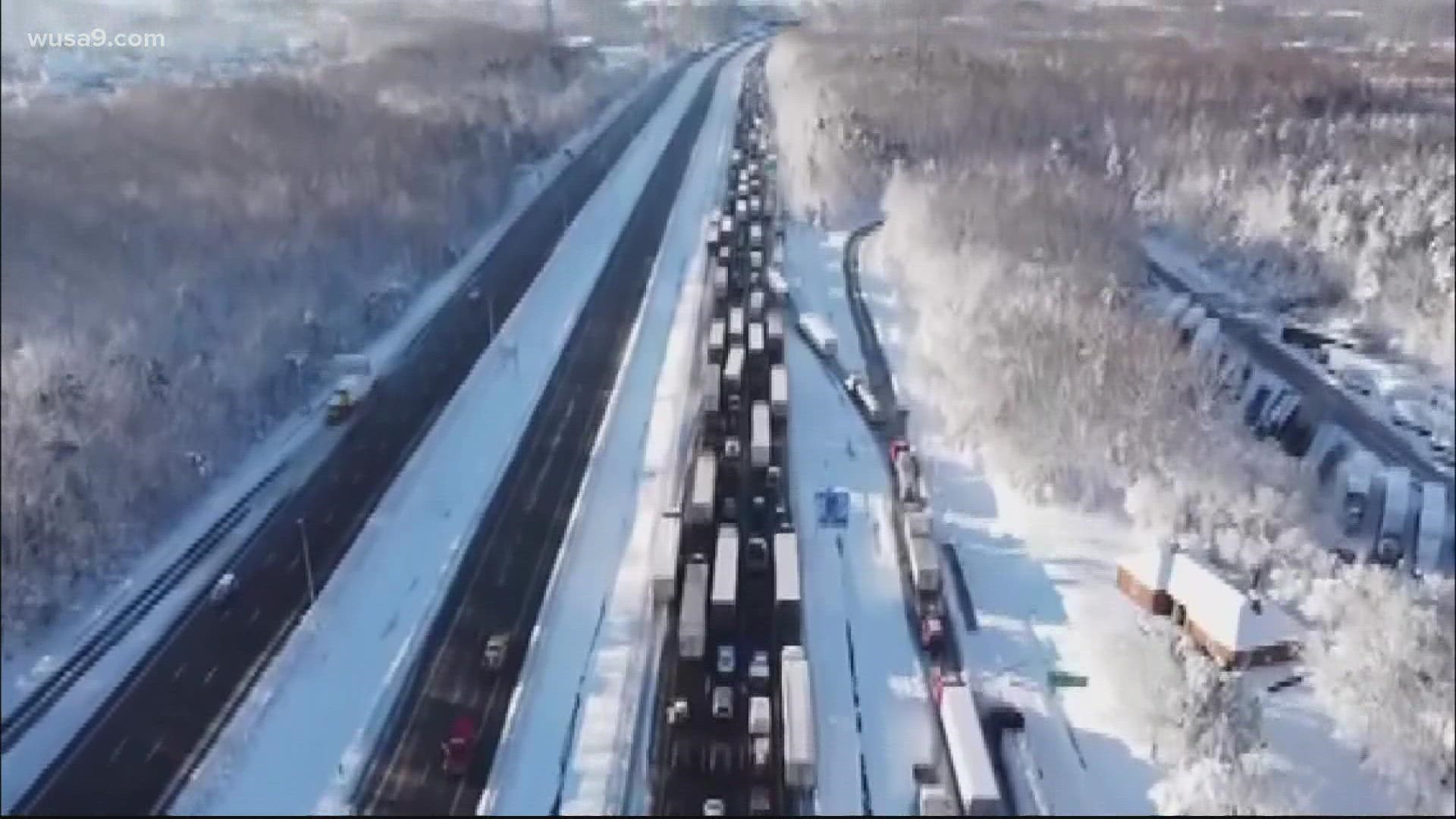FREDERICKSBURG, Va. — Nearly three months after hundreds of vehicles were stuck in standstill traffic during a snowstorm for more than 24 hours on I-95, an independent report reviewing the disaster was released Friday.
The Virginia Department of Transportation (VDOT), the Virginia Department of Emergency Management and Virginia State Police (VSP) released the report, which the agencies initiated to investigate the major traffic crisis that started on Jan. 3.
Kevin Settle, superintendent of Virginia State Police, told reporters on Jan. 4 that, surprisingly, no one was injured or killed in the 40-mile stretch of traffic that day.
On Monday, Jan. 3, the snarl started in the morning after a tractor-trailer jackknifed and more tractor trailers followed suit. As the storm started, 10 inches of snow fell in a short amount of time, VDOT Commissioner Stephen Brich told reporters on Jan. 4.
Officials were expecting the snow, but former Gov. Ralph Northam (D) told reporters on Jan. 4 that roads were not pretreated due to rain ahead of the snow According to Northam, the rain would have rendered the treatment useless, so instead officials tried warning drivers to stay off the road ahead of the storm. But, officials were not prepared as a sheet of ice was quickly formed, complicating clearing the large vehicles from the roadway.
CNA's Institute for Public Research, a nonprofit based in Arlington, conducted an independent review of the traffic incident and compiled a 40 page report of its findings.
The report lays out how the road conditions got so bad, why VDOT failed to keep up with snow removal, why the highway wasn't closed sooner and more.
9 reasons the roads got so bad, according to the report
Here are CNA's findings about why the roads became so bad.
- Weather was warm ahead of the storm, which may have "lessened public attention to the numerous VDOT, VSP, and VDEM messages and travel warnings."
- Flights were canceled around this time due to staffing shortages from the Omicron variant of COVID-19. Traffic was 65% heavier — compared to the same days in 2019 — on I-95 on Jan. 2 after the New Year's holiday and into the early day of Jan. 3.
- Snow was falling so quickly on Jan. 3 that VDOT, especially in Fredericksburg, fell behind plowing and treating areas.
- Closing I-95 to pretreat roads earlier on Jan. 3 would have been helpful, but this was not considered a viable solution prior to or during the day by VDOT and VSP.
- There were communication issues from the storm — a VSP communications center lost power which limited staff from passing on the information because dispatch capabilities were out for 30 minutes; situational awareness was lost by state agencies and so the locations of blockages on I-95 could not be verified.
- VDOT in Fredericksburg's communication was complicated because of "inoperable cell towers and widespread power outages that affected district facilities and staff working remotely."
- VDOT was experiencing COVID-related staffing shortages in some districts, which affected safety services patrols and traffic monitors.
- VSP and VDOT determined that there were limited options for emergency travel and believed allowing the public to use express lanes "risked blocking them as well." So, late in the afternoon on Jan. 3, VDOT and Transurban closed all express lanes.
- The emotional impact of the standstill traffic on drivers was not considered, since many people told the media they felt "abandoned." This message shows its important to consider the messaging sent during crisis communications, such as weather emergencies.
How Virginia officials should approach a situation like this in the future
Here are the conclusions made in the report:
- Officials need to better understand the challenges ahead of a major weather incident. For instance, there was an increase in tractor-trailer traffic on I-95. Traffic patterns should be better analyzed and agencies should respond accordingly with increased staffing and mobilization plans.
- Plan for large-scale closures and not just smaller incidents that happen during severe winter events. Because of changing weather conditions, it's important to consider longterm plans for extended interstate closures in the Commonwealth.
- Maintain better situational awareness in terms of not just being prepared to handle a winter event forecast, but also be prepared with resources for the possibility of a more significant event.
- Messaging to the public needs to be significantly improved, better amplified and distributed in a variety of ways — not just with social media and interviews, but more directly with the public. The public also needs to stay better aware and informed during weather emergencies.
Youngkin blames Northam administration for traffic nightmare following release of report
Virginia Gov. Glenn Youngkin (R) released a statement following the release of the report and blamed the traffic incident on poor communication and preparation from "the previous administration." He touted in the statement that his administration has so far "weathered three big snowstorms successfully" since Northam, the former governor, left office.
"Since assuming office on January 15th, our administration has worked very closely with Virginia State Police, our Virginia National Guard, the Virginia Department of Emergency Management, and the Virginia Department of Transportation responding quickly and adequately to each incoming weather related event and I've been incredibly pleased with our execution," Youngkin's statement says. "Virginians can trust that we are working to keep them safe."
Northam's office could not immediately be reached for comment Friday.
Sign up for the Get Up DC newsletter: Your forecast. Your commute. Your news.
Sign up for the Capitol Breach email newsletter, delivering the latest breaking news and a roundup of the investigation into the Capitol Riots on January 6, 2021.

